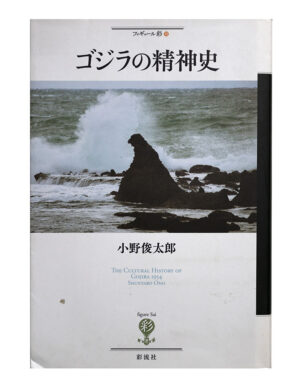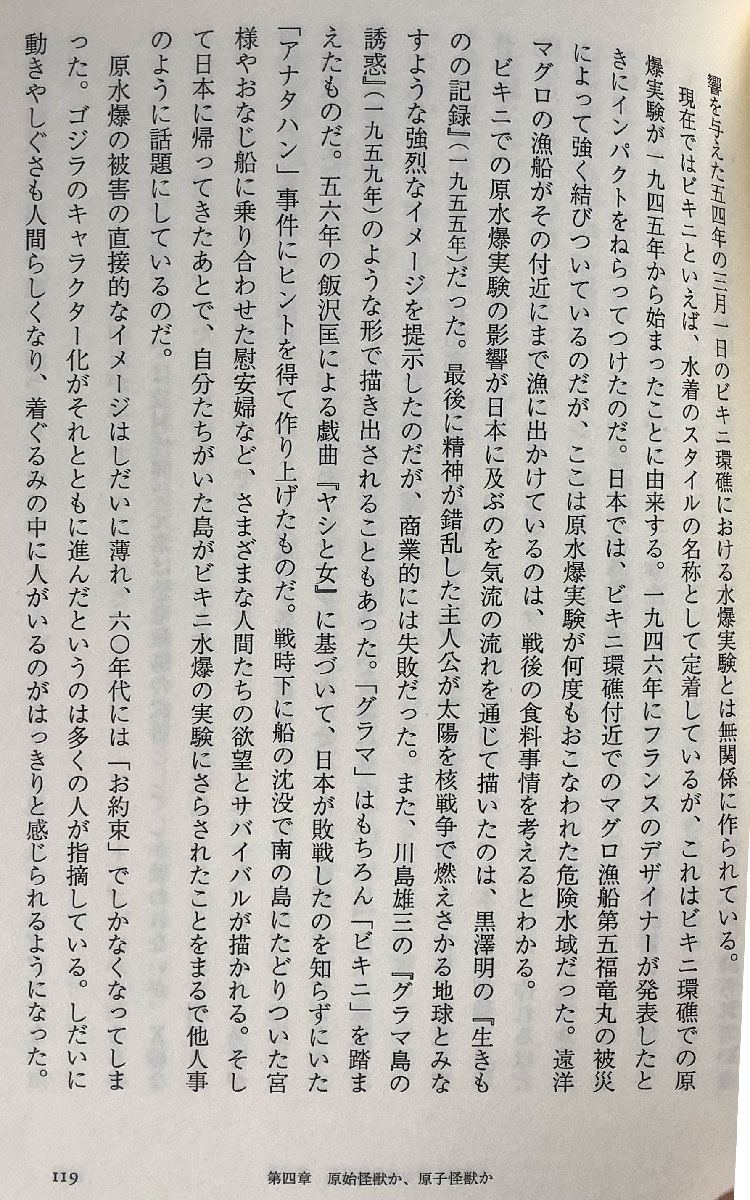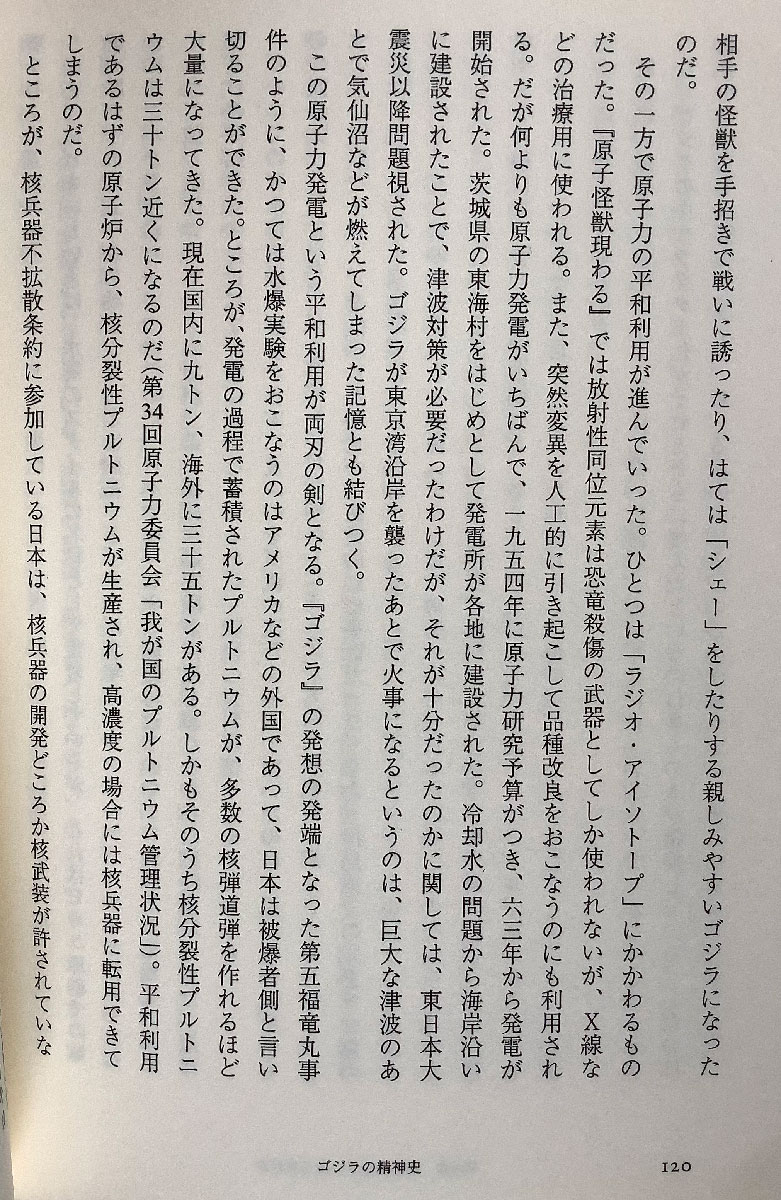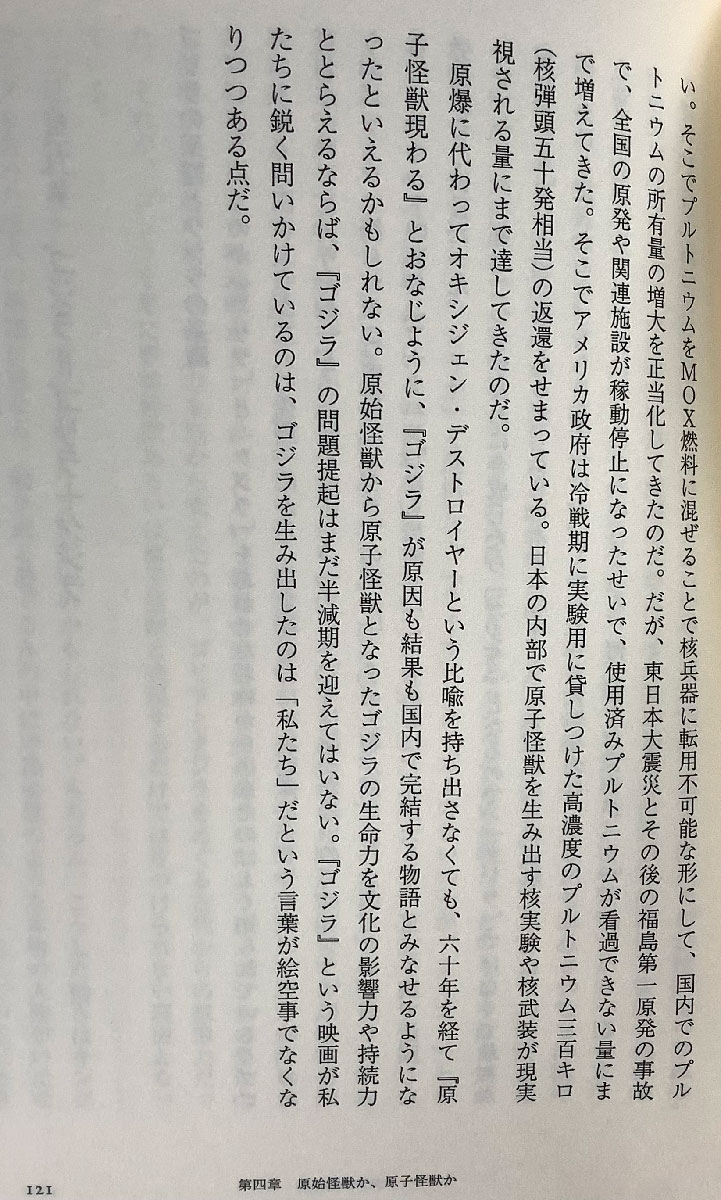5.29.2023
The Cultural History of Godzilla – Pt 46


P 118 b
原子力の平和利用へ
Towards peaceful uses of nuclear energy
では、二百万年の眠りから目覚めた原始怪獣ではなくて、放射能の炎を吐く原子怪獣としてのゴジラはどういう意味合いをもつのだろうか。リドサウルスを目覚めさせたのは、アメリカ軍自身による実験だった。爆発の瞬間の閃光から目を保護するために全員が黒いサングラスをかけるという核実験でおなじみの場面が描きだされている。出現の原因も始末をつけるのも、あくまでもアメリカ「国内」の出来事という扱いである。しかも、『原子怪獣現わる』は五三年の映画だから、『ゴジラ』に影響を与えた五四年の三月一日のビキニ環礁における水爆実験とは無関係に作られている。
So what is the significance of Godzilla as an atomic monster that breathes radioactive flames, rather than a primitive monster that has awakened from a two-million-year slumber? It was an experiment by the American military itself that awakened the rhidosaurus. It depicts a familiar scene from nuclear testing, in which everyone wears black sunglasses to protect their eyes from the flash of light at the moment of the explosion. Both the cause of its appearance and its disposal are treated as domestic events in the United States. What’s more, “The Beast from 20,000 Fathoms” is a 1953 film, so it was made regardless of the March 1, 1954 hydrogen bomb test at Bikini Atoll that influenced “Godzilla.”

P 119
現在ではビキニといえば、水着のスタイルの名称として定着しているが、これはビキニ環礁での原爆実験が一九四五年から始まったことに由来する。一九四六年にフランスのデザイナーが発表したときにインパクトをねらってつけたのだ。日本では、ビキニ環礁付近でのマグロ漁船第五福竜丸の被災によって強く結びついているのだが、ここは原水爆実験が何度もおこなわれた危険水域だった。遠洋マグロの漁船がその付近にまで漁に出かけているのは、戦後の食料事情を考えるとわかる。
Today, bikinis are the name of the style of swimwear, and this originates from the fact that atomic bomb tests began at Bikini Atoll in 1945. In 1946, a French designer put it on to make an impact. In Japan, they are strongly linked by the disaster of the Daigo Fukuryu Maru, a tuna fishing vessel near Bikini Atoll, which was a dangerous area where many atomic and hydrogen bomb tests were conducted. Considering the food situation after the war, it is understandable that deep-sea tuna fishing boats go fishing in the vicinity.
ビキニでの原水爆実験の影響が日本に及ぶのを気流の流れを通じて描いたのは、黒澤明の『生きものの記録』(一九五五年)だった。最後に精神が錯乱した主人公が太陽を核戦争で燃えさかる地球とみなすような強烈なイメージを提示したのだが、商業的には失敗だった。また、川島雄三の『グラマ島の誘惑』(一九五九年)のような形で描き出されることもあった。「グラマ」はもちろん「ビキニ」を踏まえたものだ。五六年の飯沢匡による戯曲『ヤシと女』に基づいて、日本が敗戦したのを知らずにいた「アナタハン」事件にヒントを得て作り上げたものだ。戦時下に船の沈没で南の島にたどりついた宮様やおなじ船に乗り合わせた慰安婦など、さまざまな人間たちの欲望とサバイバルが描かれる。そして日本に帰ってきたあとで、自分たちがいた島がビキニ水爆の実験にさらされたことをまるで他人事のように話題にしているのだ。
It was Akira Kurosawa’s “I Live in Fear” (1955) that depicted the effects of the atomic and hydrogen bomb tests in Bikini on Japan through the flow of air currents. At the end, the deranged protagonist presents a powerful image of the sun as the earth blazing with nuclear warfare, but it was a commercial failure. In addition, it was sometimes depicted in the form of Yuzo Kawashima’s “Temptation on Glamour Island” (1959). “Glamour” is of course based on “bikini.” Based on Tadashi Iizawa’s 1956 drama “Yashi to Onna,” it was inspired by the “Anatahan” incident, in which Japan was unaware of its defeat in the war. It depicts the desires and survival of various human beings, such as a prince who ended up on a southern island due to the sinking of a ship during the war, and comfort women who boarded the same ship. And after returning to Japan, they are talking about the fact that the island they were on was exposed to the bikini hydrogen bomb test as if it were someone else’s problem.
“I Live in Fear” is an expressive, caustic, portrait of madness. Toshiro Mifune plays an aging industrialist driven to madness over fears of a nuclear attack. The most frightening aspect of Kurosawa’s film is not the threat of nuclear annihilation, but the proliferation of man’s inhumanity and greed, expressed by the family’s zeal to commit their father and keep their inheritances intact. (Source: Google)
原水爆の被害の直接的なイメージはしだいに薄れ、六〇年代には「お約束」でしかなくなってしまった。ゴジラのキャラクター化がそれとともに進んだというのは多くの人が指摘している。しだいに動きやしぐさも人間らしくなり、着ぐるみの中に人がいるのがはっきりと感じられるようになった。
The direct image of the damage caused by the atomic and hydrogen bombs gradually faded, and in the 1960s it became nothing more than a “promise.” Many people have pointed out that the characterization of Godzilla went along with it. Gradually, their movements and gestures became more human-like, and it became clear that there was a person inside the costume.

P 120
相手の怪獣を手招きで戦いに誘ったり、はては「シェー」をしたりする親しみやすいゴジラになったのだ。
It has become a friendly Godzilla that invites opponent monsters into battle by beckoning them, and even does the “Shee.”
その一方で原子力の平和利用が進んでいった。ひとつは「ラジオ・アイソトープ」にかかわるものだった。『原子怪獣現わる』では放射性同位元素は恐竜殺傷の武器としてしか使われないが、X線などの治療用に使われる。また、突然変異を人工的に引き起こして品種改良をおこなうのにも利用される。だが何よりも原子力発電がいちばんで、一九五四年に原子力研究予算がつき、六三年から発電が開始された。茨城県の東海村をはじめとして発電所が各地に建設された。冷却水の問題から海岸沿いに建設されたことで、津波対策が必要だったわけだが、それが十分だったのかに関しては、東日本大震災以降問題視された。ゴジラが東京湾沿岸を襲ったあとで火事になるというのは、巨大な津波のあとで気仙沼などが燃えてしまった記憶とも結びつく。
At the same time, the peaceful uses of nuclear energy have advanced. One involved “radio isotopes.” In “The Beast from 20,000 Fathoms,” radioactive isotopes are used only as weapons to kill dinosaurs, but they are used for treatment such as X-rays. It is also used to artificially induce mutations to improve breeds. But above all, nuclear power generation is the best, and in 1954 the budget for nuclear research was provided, and in 1963 power generation began. Power plants were built in various places, including Tokai Village in Ibaraki Prefecture. Because it was built along the coast due to the problem of cooling water, it was necessary to take measures against tsunami, but after the Great East Japan Earthquake, it was questioned whether it was sufficient. The fire after Godzilla attacked the coast of Tokyo Bay is also related to memories of Kesennuma and other places burning after a huge tsunami.
この原子力発電という平和利用が両刃の剣となる。『ゴジラ』の発想の発端となった第五福竜丸事件のように、かつては水爆実験をおこなうのはアメリカなどの外国であって、日本は被爆者側と言い切ることができた。ところが、発電の過程で蓄積されたプルトニウムが、多数の核弾道弾を作れるほど大量になってきた。現在国内に九トン、海外に三十五トンがある。しかもそのうち核分裂性プルトニウムは三十トン近くになるのだ(第34回原子力委員会「我が国のプルトニウム管理状況」)。平和利用であるはずの原子炉から、核分裂性プルトニウムが生産され、高濃度の場合には核兵器に転用できてしまうのだ。
This peaceful use of nuclear power is a double-edged sword. Like the Daigo Fukuryu Maru Incident, which gave rise to the idea of “Godzilla,” it was once possible to assert that hydrogen bomb tests were conducted by foreign countries such as the United States, while Japan was on the side of the hibakusha. However, the amount of plutonium accumulated in the process of power generation has become so large that it can be used to create a large number of nuclear ballistic missiles. Currently, there are 9 tons domestically and 35 tons overseas. Moreover, the amount of fissile plutonium will be close to 30 tons (The 34th Atomic Energy Commission, “Japan’s Plutonium Management Situation”). Fissile plutonium is produced from nuclear reactors that are supposed to be for peaceful use, and if the concentration is high, it can be diverted to nuclear weapons.
Hibakusha is an atomic bomb victim (esp. of Hiroshima and Nagasaki) (Source: Jisho.org)
ところが、核兵器不拡散条約に参加している日本は、核兵器の開発どころか核武装が許されていない。
However, Japan, which is a party to the Treaty on the Non-Proliferation of Nuclear Weapons, is not allowed to develop or even arm itself with nuclear weapons.

P 121
そこでプルトニウムをMOX燃料に混ぜることで核兵器に転用不可能な形にして、国内でのプルトニウムの所有量の増大を正当化してきたのだ。だが、東日本大震災とその後の福島第一原発の事故で、全国の原発や関連施設が稼動停止になったせいで、使用済みプルトニウムが看過できない量にまで増えてきた。そこでアメリカ政府は冷戦期に実験用に貸しつけた高濃度のプルトニウム三百キロ(核弾頭五十発相当)の返還をせまっている。日本の内部で原子怪獣を生み出す核実験や核武装が現実視される量にまで達してきたのだ。
Therefore, by mixing plutonium into MOX fuel, it has been made into a form that cannot be diverted to nuclear weapons, thereby justifying the increase in domestic plutonium possession. However, due to the Great East Japan Earthquake and subsequent accident at the Fukushima Daiichi Nuclear Power Plant, nuclear power plants and related facilities across the country were shut down, and the amount of used plutonium has increased to an unacceptable amount. Therefore, the US government is pressing for the return of 300 kg of high-concentration plutonium (equivalent to 50 nuclear warheads) that it lent for experiments during the Cold War. The amount of nuclear testing and nuclear armament that creates atomic monsters inside Japan has reached a level that can be seen as a reality.
原爆に代わってオキシジェン・デストロイヤーという比喩を持ち出さなくても、六十年を経て『原子怪獣現わる』とおなじように、『ゴジラ』が原因も結果も国内で完結する物語とみなせるようになったといえるかもしれない。原始怪獣から原子怪獣となったゴジラの生命力を文化の影響力や持続力ととらえるならば、『ゴジラ』の問題提起はまだ半減期を迎えてはいない。『ゴジラ』という映画が私たちに鋭く問いかけているのは、ゴジラを生み出したのは「私たち」だという言葉が絵空事でなくなりつつある点だ。
Even if we don’t use the analogy of an oxygen destroyer to replace the atomic bomb, after 60 years, just like “The Beast from 20,000 Fathoms,” “Godzilla” can be regarded as a story in which both cause and effect are completed within Japan. If we take Godzilla’s life force, which has changed from a primitive monster to an atomic monster, as the influence and endurance of culture, the question raised by “Godzilla” has not yet reached its half-life. What the movie “Godzilla” asks us is that the phrase “we” who created Godzilla is no longer a fiction.